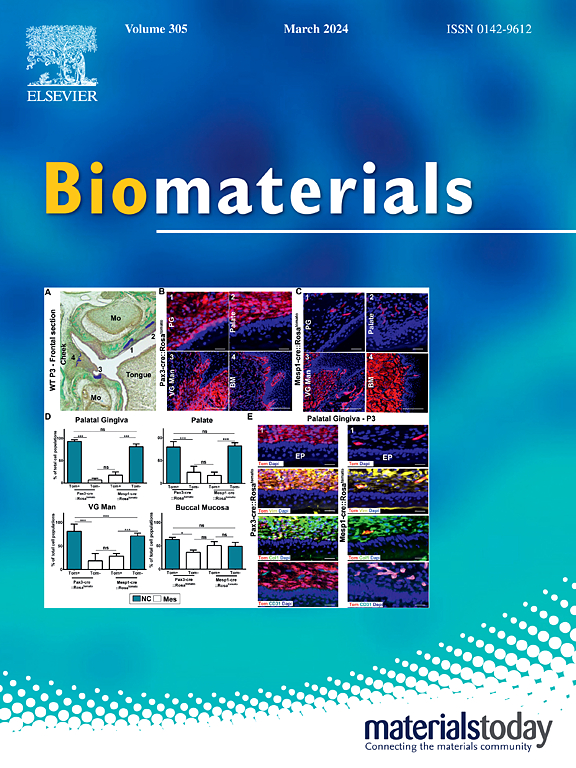Biodegradable polymers with tertiary amines enhance mRNA delivery of lipid nanoparticles via improved endosomal escape
IF 12.9
1区 医学
Q1 ENGINEERING, BIOMEDICAL
引用次数: 0
Abstract
Messenger RNA (mRNA)-based therapy has become a promising and scalable approach for treating various diseases, and lipid nanoparticles (LNPs) have recently gained prominence as a safe and effective delivery vehicle. LNPs not only protect mRNA from degradation during systemic circulation but also facilitate its intracellular uptake and endosomal release. However, the endosomal release efficiency of standard LNPs has been shown to be poor, limiting the transfection efficiency. Here, we explored incorporating a biodegradable polymer which only contains tertiary amines as a pH-sensitive functional group into LNPs, aiming to introduce the proton sponge effect to facilitate the endosomal release. We developed a series of novel LNP formulations by spiking the polymers with different molecular weights into LNPs at a range of ratios. Our results demonstrated that the polymer-modified LNPs (p-LNPs) maintained a particle size of approximately 80 nm, a neutral surface charge, and an mRNA encapsulation efficiency >90 %, along with increased pH buffering capacity. The optimal p-LNP formulation tripled the cellular uptake and enhanced the endosomal escape efficiency from 20 % to 80 % compared to the standard LNPs. Furthermore, cells treated with the p-LNP formulation at 1 mg/mL showed no cytotoxicity. Upon intravenous administration, the optimal p-LNP formulation loaded with luciferase mRNA significantly increased the transgene expression evidenced by a 100-fold increase in luciferin bioluminescence from the liver compared to the standard LNPs. Moreover, p-LNPs did not elevate inflammatory cytokines in the treated mice, including IFN-gamma, IL1β, TNFα, and IL6.

具有叔胺的可生物降解聚合物通过改善内体逃逸增强脂质纳米颗粒mRNA的传递
基于信使RNA (mRNA)的治疗已经成为治疗各种疾病的一种有前途和可扩展的方法,而脂质纳米颗粒(LNPs)作为一种安全有效的递送载体最近得到了重视。LNPs不仅保护mRNA在体循环中不被降解,而且还促进mRNA在细胞内的摄取和内体释放。然而,标准LNPs的内体释放效率较差,限制了转染效率。本研究探索将一种仅含叔胺的生物可降解聚合物作为ph敏感官能团加入LNPs中,旨在引入质子海绵效应促进内体释放。我们开发了一系列新的LNP配方,将不同分子量的聚合物以一定的比例注入LNP中。我们的研究结果表明,聚合物修饰的LNPs (p-LNPs)保持了约80 nm的粒径,中性的表面电荷,mRNA的包封效率>; 90%,同时增加了pH缓冲能力。与标准LNPs相比,优化后的p-LNP的细胞摄取增加了两倍,内体逃逸效率从20%提高到80%。此外,1 mg/mL的p-LNP制剂对细胞无细胞毒性。经静脉给药后,负载荧光素酶mRNA的最佳p-LNP配方显著提高了转基因表达,肝脏荧光素生物发光比标准LNPs增加了100倍。此外,p-LNPs不会升高治疗小鼠的炎症细胞因子,包括ifn - γ、il - 1β、tnf - α和il - 6。
本文章由计算机程序翻译,如有差异,请以英文原文为准。
求助全文
约1分钟内获得全文
求助全文
来源期刊

Biomaterials
工程技术-材料科学:生物材料
CiteScore
26.00
自引率
2.90%
发文量
565
审稿时长
46 days
期刊介绍:
Biomaterials is an international journal covering the science and clinical application of biomaterials. A biomaterial is now defined as a substance that has been engineered to take a form which, alone or as part of a complex system, is used to direct, by control of interactions with components of living systems, the course of any therapeutic or diagnostic procedure. It is the aim of the journal to provide a peer-reviewed forum for the publication of original papers and authoritative review and opinion papers dealing with the most important issues facing the use of biomaterials in clinical practice. The scope of the journal covers the wide range of physical, biological and chemical sciences that underpin the design of biomaterials and the clinical disciplines in which they are used. These sciences include polymer synthesis and characterization, drug and gene vector design, the biology of the host response, immunology and toxicology and self assembly at the nanoscale. Clinical applications include the therapies of medical technology and regenerative medicine in all clinical disciplines, and diagnostic systems that reply on innovative contrast and sensing agents. The journal is relevant to areas such as cancer diagnosis and therapy, implantable devices, drug delivery systems, gene vectors, bionanotechnology and tissue engineering.
 求助内容:
求助内容: 应助结果提醒方式:
应助结果提醒方式:


